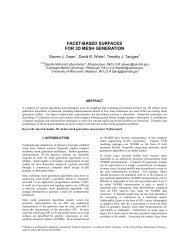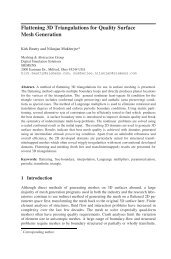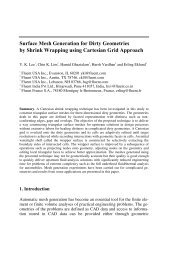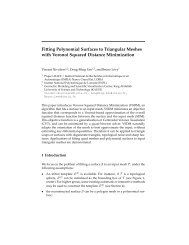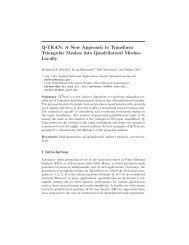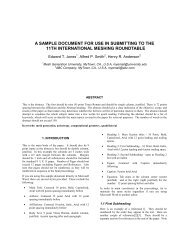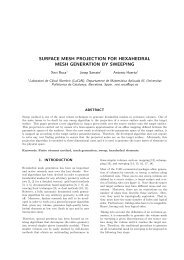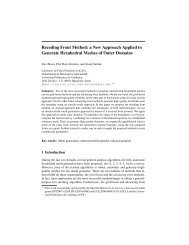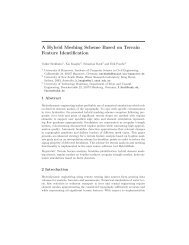CPU-GPU Algorithms for Triangular Surface Mesh Simplification
CPU-GPU Algorithms for Triangular Surface Mesh Simplification
CPU-GPU Algorithms for Triangular Surface Mesh Simplification
Create successful ePaper yourself
Turn your PDF publications into a flip-book with our unique Google optimized e-Paper software.
14 Suzanne M. Shontz and Dragos M. Nistor% <strong>GPU</strong> timemesh 95-5 90-10 85-15 80-20 75-25 70-30 65-35 60-40 55-45 50-50armadillo 8.2 13.3 18.2 22.8 27.4 31.9 36.2 40.5 44.7 48.7bunny 5.0 8.3 11.5 14.4 17.3 20.1 22.7 25.5 27.6 29.8gargoyle 9.2 14.4 19.5 24.4 29.2 33.8 38.3 42.6 46.8 51.0hand 8.3 13.5 18.4 23.1 27.8 32.5 36.9 41.3 45.6 49.7horse 4.7 7.7 10.5 13.1 15.7 18.1 20.4 22.5 24.6 26.5kitten 7.4 12.4 17.2 21.8 26.3 30.7 34.8 38.9 43.0 46.8mesh 45-55 40-60 35-65 30-70 25-75 20-80 15-85 10-90 5-95 0-100armadillo 52.6 56.4 59.8 63.4 66.7 69.7 72.4 75.0 77.2 79.0bunny 31.9 33.9 35.7 37.4 39.1 40.5 41.9 43.2 44.5 45.7gargoyle 55.1 58.9 62.7 66.2 69.7 73.0 76.0 79.0 81.7 83.4hand 53.7 57.6 61.1 64.9 68.3 71.4 74.2 76.9 79.2 81.1horse 28.2 28.8 31.4 32.6 33.9 34.9 35.9 36.8 37.5 38.1kitten 50.7 54.3 57.8 61.3 64.5 67.5 70.3 73.0 75.6 77.1Table 7. The percentage of time spent using the <strong>GPU</strong> <strong>for</strong> various <strong>CPU</strong>-<strong>GPU</strong> splitsusing the inverse reduction algorithm.The following metrics were collected after 10 iterations of the algorithmwith a <strong>CPU</strong>-<strong>GPU</strong> split of 0-100: vertex and face counts, minimum and maximumelement angles (in degrees), minimum and average element area, meshvolume, and vertex and face simplification percentages. The values <strong>for</strong> thesemetrics <strong>for</strong> the tenth iteration can be seen in Table 8.mesh # vertices # faces min ∠ max ∠ min area avg area volumearmadillo 65091 129131 2.271e-2 179.949 1.656e-07 5.190e-1 1.42659e+6bunny 13043 25936 5.214e-2 179.805 1.000e-07 4.455e-2 7.55771e+3gargoyle 351150 693992 3.044e-3 179.991 3.046e-08 1.211e-1 1.64145e+6hand 132063 259374 1.449e-2 179.920 8.594e-10 2.940e-4 1.64892e+1horse 6623 12719 1.251e-2 179.520 6.054e-11 5.698e-6 1.58656e-3kitten 53725 106863 1.076e-2 179.912 1.476e-06 2.404e-1 8.38289e+5Table 8. Values of the metrics <strong>for</strong> the meshes after 10 iterations of the <strong>CPU</strong>-<strong>GPU</strong>inverse reduction algorithm.<strong>Simplification</strong> using the inverse reduction algorithm does not affect thevolume of the test cases significantly. It does, however, increase the averagearea of each element, which is to be expected. Additionally, the simplificationrate is approximately 9% to 10% after one iteration of the algorithm, which ismuch lower than that of the naïve algorithm. This demonstrates the tradeoffbetween speed and rate of compression.We also consider the simplification rate after per<strong>for</strong>ming 10 iterations ofthe <strong>CPU</strong>-<strong>GPU</strong> inverse reduction algorithm on the test meshes. The simplifi-



